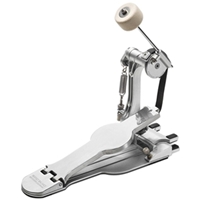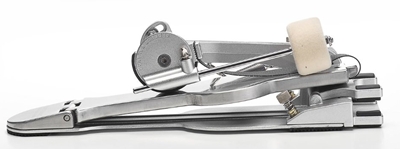Saturday, August 11, 2012
Friday, August 10, 2012
Comping and off-beat grooves versus mindlessly hitting on 2 and 4
This post will extend the groove possibilities to include playling off beat and comping rhythms. The best introduction these concepts is this video by Peter Erskine:
Before proceeding go to this link and check out the examples, and pay special attention to Charlie Smith's playing behind Bird and Dizzy in the Hot House video.
Back? Here are some more lessons that will impart some very basic and easy-to-learn skills in comping:
An interesting video I came across and liked
My final video is of Peter Erskine in performance demonstrating comping. Unless you are playing heavy backbeat music that is formulaic, try experimenting with comping patterns instead of mindlessly hitting on 2 and 4. Also practice off beat playing per Erskine's video on that subject. You are still providing a time reference with the 2 and 4 on your hi-hat, along with time via your ride pattern (and it can be unswung, straight quarter or eigth notes). Playing on the up beat, for example, can propel the groove.
Granted, some of these things may not fit into your music or comfort zone - for the time being at least - but trying them out and experimenting will open you to many more possibilities.
Here is the final clip:
One parting word: if you haven't checked out Tommy Igoe's Groove Essentials video, I highly recommend it. See my 18 February 2010 post, My Favorite Instructional Videos for details and other recommendations. You can also head over to this post about Giant Steps and listen to how comping is done on a world class, iconic album.
Wednesday, August 8, 2012
An innovation in ... hardware bags!

This bag was designed to hold three cymbal stands, a hi-hat and snare stand. The innovation is each stand gets its own pocket to protect the chrome instead of rattling around inside a bag or case and chipping or marring the finish.
While the design will protect those hardware pieces, you will still need a bag for your throne, bass drum pedal and any ancillary gear and parts you carry. In my case I hand carry in my throne and use a Gibraltar single pedal bag for my pedal and spare parts. You may already have that covered if your pedal came with a bag or case. Another option is a smaller bag for the rest of the gear. I use a Beato Pro 3 25 inch bag for everything else. For me, that bag is ideal, and should work for you - especially if you have a lot of other gear and a double-pedal. Put your high-end stands in the Stagg pocketed bag and the other gear in the Beato one.
Most of my hardware is from the DW 6700 flush stands series, which is pricey. This bag protects them beautifully.
If you are using high-end (i.e., expensive) stands this bag will protect them better than any other bag I have seen. You could individually wrap each of your stands in towels before putting them in a standard hardware bag, and save the price of this bag, but that is going to increase your set up and tear down time.
Tuesday, August 7, 2012
Jojo Mayer Bass Pedal follow-up

This is a follow-up with some additional thoughts after I had a cursory, hands-on session with one.
Jojo Mayer has spent over a decade designing this pedal, swinging the pendulum back to old school style pedals.
Some of the design goals included non-accelerating cams and strap drives. Before proceeding, understand that I am basing my five star rating and effusive comments on my personal perspective. I am a jazz drummer who plays heel-down and who started playing in 1964 when the emphasis was on what was done on top of the kit with the bass drum relegated to a time and pulse keeping instrument. So my needs are probably not in line with more modern drumming styles, and definitely not rock drumming where 16th notes on the bass drum are the norm.
The claim that this pedal is almost invisible to your touch is true from my brief (thus far) experience. It reminds me of the Axis X-L Longboard Single Drum Pedal from both a touch and response perspective, as well as the long board configuration. In addition, this pedal shares the single post design with the Axis.

An advantage (to me) is it allows me to move my foot as far forward as I want to shorten and control my stroke for very light playing.
The other hand, the old school beater (very much like the Ludwig Felt Bass Drum Pedal Beater) is a plus to me, although I generally use the Vater Vintage Bomber beater for the type of music I play. But that fact should also clue you as to where I am coming from when you are deciding if this is the pedal for you.
What I do not much care for, but can live with, is the split foot plate where you have the foot and feel plates separate. I prefer the Axis cited above or the Ludwig Speed King, both of which have a single plate. But, that is a personal preference and - remember - I am a strictly heel down player. Do not allow my preferences to deter you from checking this pedal out.
Other things I love include the fact that this pedal quickly folds flat, and when you are unfolding it, the clamping mechanism automatically engages your bass from hoop as you bring it into the playing configuration. Another nice touch is the carrying case that is included.


The only thing I strongly dislike - and this is a personal preference - is how narrow the foot board is. True, there is a round portion where you can place your toe or to provide a stable resting point for your foot, but it is disconcerting for me. Many players use a lateral motion to get speed. For those this foot board design is probably perfect. I, on the other hand, do not play fast bass drum patterns so any advantages of that design feature are lost on me.

Despite my minor complaints I think Sonor's 'Sonor Perfect Balance' name is an apt description. This is one of the most balanced, responsive and natural pedals on the market today. Jojo Mayer did an excellent job designing it, and Sonor's engineers took that design and created an amazing pedal that swings the pendulum back old school feeling with modern technology.
Monday, August 6, 2012
K Custom Session Cymbals
I do not use crash cymbals, so I cannot comment on it. And since the 18" ride is no longer available, anything I can say about it is moot (although I did think it was a little too bright for my tastes - back then, anyway.)
The 14" hi-hats are versatile in my opinion. versatile. The only two other multi-purpose pairs I like more are the Armand 14" hats and the A. Zildjian & Cie "Vintage hi-hats.
They have a strange design based on an old pair of Istanbul K. Zildjian hats Steve Gadd used to own. The top is heavier and slightly smaller than the bottom (the top is 13-15/16" and the bottom exactly 14"). This configuration gives the hats a surprisingly responsive feel, and I like the sound - especially with the top hat loose in the clutch.
Unlike the ride cymbals in the K. Custom Session series, which sound great out front, but terrible behind the kit, these hats are great sounding to both the drummer and audience. And they can project if needed, or will give subtle notes if played softly. This quality makes a pair perfect for just about any music genre or playing style. They also pair nicely with other cymbals from not only Zildjian (both A and K series), but other brands too.
The 20" K Session ride cymbal, even with the factory-installed rivets, took some time to get use to.
One of the barriers to liking this (and its 18" sibling) is they sound clangy from behind the kit. Out front they actually sound pretty amazing and they also record very well.
Also, unlike other Zildjian K. Custom series, the Session series is consistent. Mine sounds practically identical to one owned by a fellow drummer. And hearing him play is what inspired me to dig out mine, which frankly had not been getting much use over the years.
This cymbal will not project, so for loud music it is not a great choice. There is a lot of definition with a slight wash when playing it, and the bell is very strong. It also crashes well.
It is versatile enough to work with jazz and blues and other quieter types of music. It may work with classic rock, but will definitely not cut through if you play heavier rock or metal.
When I received my set it came with a cymbal bag and a DVD. I managed to track down the DVD, which features Steve Gadd explaining how and why the K Session series came about. Here is the full length video, which rounds out my thoughts in this series:
Sunday, August 5, 2012
Jojo Mayer Bass Drum Pedal
His new tool is the Sonor Drums 14508401 Bass Drum Pedal:

It also goes by a few nicknames: Sonor Perfect Balance is one, and - not surprisingly - the Jojo Mayer pedal.
I do not have any firsthand experience with this pedal (I only found out about it a few hours ago), but did unearth a video by Jojo himself explaining why he designed it and what it's all about:
I love his design criteria and the final product. I was especially impressed by some convenient features, such as how it folds down compactly, and when you unfold it, it automatically engages your bass drum hoop and firmly clamps on.
Those features, though, are secondary to the feel. Again, I have not touched one, but from the look you can be sure that not only the older Gretsch and Camco pedals Jojo mentioned inspired the design, but also the venerable Speedking, and even the [still] highly regarded Ghost Pedal. As an aside, the Speedking was a collaboration between WFL and Ray Baduc, a great drummer who also collaborated with Zildjian to design the swish cymbal.
Of course I am going to check this pedal out in person. I am not sure if I will be buying one since I am pretty happy with what I have and I canme up in an era when drummers emphasized hands over feet for playing. However, Jojo's musical style is in line with mine, so who knows.
Instead of making this post completely about gear, I am going to weave in some music. In this case it's a very young Jojo backing the late, great Emily Remler on guitar and one of the top B3 players - ever in my opinion - Barbara Dennerlein.